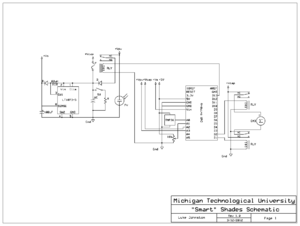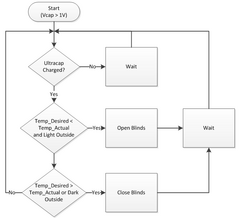
This page contains methods on the topic of "smart" solar shades using PV.
To see the literature review of this topic, click here
The "Smart" solar shade project is designed to be a two step process: first to simulate the potential savings by utilizing an automated window shade system is utilized to heat or cool a room, followed by then demonstrating such a system experimentally.
Simulation[edit | edit source]
Please spend some time thinking about this after you build and have a working prototype how do we move that towards publication see email in relation to simulation ideas
Experiment[edit | edit source]
Hardware[edit | edit source]
Design Considerations[edit | edit source]
Component Sizing[edit | edit source]
Electric Motor[edit | edit source]
Servo, stepper, and DC motors were considered for the window blind actuation. The cheapest option was found to be a geared hobby motor utilizing a potentiometer for position feedback. The GM3 geared hobby motor provides up to.34 Nm of torque at ultracapacitor voltage.
Ultracapacitor[edit | edit source]
The power storage component was fortunately given from a cost standpoint, but unfortunate from an engineering standpoint. It is governed by the relationship of current to the change in voltage in a capacitor.
- .
Given that the voltage range of the ultracapacitor to be 1.0-2.7V dictated by the maximum ratings of the ultracapacitor and minimum ratings of the DC-DC converter, this means the voltage may drop 1.7V. This equates to approximately 6.9 KJ of energy, enough to run the selected motor at its maximum power at 3V for over an hour - much longer than is needed.
Link here to all the ultracap info for the models we are using.
PV Panel[edit | edit source]
The PV panel is still yet to be determined, however, it would be best if its open circuit voltage is close to 2.7 volts. This would prevent the ultracapacitor from overcharging no matter what.
update
DC-DC Converter[edit | edit source]
Given that the Arduino Uno used as the controller in this experiment is powered off of a 5V power source, a method is needed to convert the ultracapacitor voltage. Using Digikey's search feature, a number of DC-DC converters were found to output 5v. The LT1073-5 was selected due to the few number of external components needed, as well as its low required input voltage (1V).
Ultracapacitor Safety[edit | edit source]
Due to the high energy content and discharge rate of the ultracapacitor, considerations must be taken into account to keep the ultracapacitor from being over charged. A relay is put in between the PV panel and ultracapacitor. It is normally closed, so it's default action is to charge the ultracapacitor. However, the Arduino controller has control of the relay and reads in the ultracapacitor voltage as an analog input. If this voltage is deemed to high, the Arduino has control to cut power to the ultracapacitor.
Since there is a potential hazard to use such a large capacitor such as the 3000F Maxwell capacitor used in this experiment, a method is needed to easily and safely discharge the capacitor. A power resistor is put in parallel with the ultra capacitor with a switch in series for this reason. In practice, it may be useful to have this feature for time when users are away from the room for extended periods of time such as vacations.
Hardware List[edit | edit source]
| Description | Function | Model/Part # | Supplier | Unit Price | Quantity | URL | Comments |
|---|---|---|---|---|---|---|---|
| DC Motor | Blind actuation | GM3 | Solarbotics.com | 5.75 | Blind_Number | http://www.solarbotics.com/products/gm3/ | Price for buying 2-20 units |
| Trimpot | Blind position feedback | RT10k | Solarbotics.com | 1.1 | Blind_Number | http://www.solarbotics.com/products/rt10k/ | |
| SPDT Relay | Switching motor/cutting charging | 3.5 | 2*Blind_Number +1 | ||||
| SPST switch | For discharging ultracapacitor | 1 | |||||
| PV panel | Power source | 1 | |||||
| Ultracapacitor | Power storage | BCAP3000 E270 T04 | Maxwell | 1 | http://www.maxwell.com/products/ultracapacitors/products/k2-series | In hand | |
| Temp sensor | Room temperature sensing | TMP36 | Digikey | 1 | In hand | ||
| Controller | Arduino Uno | Arduino | |||||
| Perf board | PCB | ||||||
| Project Box | Enclosure for components | ||||||
| Misc electronics | For DC-DC converter | In hand | |||||
| Power resistor | For discharging ultracapacitor | Digikey | |||||
| DC-DC Converter | Boost from UC to +5V | LT1073-5 | Digikey | 1 | http://search.digikey.com/us/en/products/LT1073CN8%23PBF/LT1073CN8%23PBF-ND/889104 | ||
| Fuse holder | Holds fuse | Digikey | 1.21 | 1 | http://search.digikey.com/us/en/products/02540101Z/F1471-ND/553102 | ||
| Fuse | To fuse power from UC | Digikey | 0.71 | 3 | http://search.digikey.com/us/en/products/0229003.HXP/F2470-ND/777186 | ||
| Misc hardware | For mounting components in project box | ||||||
| Wire | For wiring components | ||||||
| Diode | Circuit protection | 1N5817 | Digikey | 0.42 | 2 | http://search.digikey.com/us/en/products/1N5817-TP/1N5817-TPCT-ND/950586 | |
Logic[edit | edit source]

A simple high-level control scheme is implemented initially as a proof of concept. It essentially compares the desired temperature to room temperature and opens or closes the blinds based on temperature difference. When the PV panel is decoupled from the ultracapacitor, open circuit voltage of the PV can be taken to determine sunlight. Ideally, transients are expected twice a day in order to decrease power demand.
In future iterations of this project, more complex models may be used. Since the blinds in this system have position feedback, it is possible to operate them at many different angles.
please see notes in email about logic
